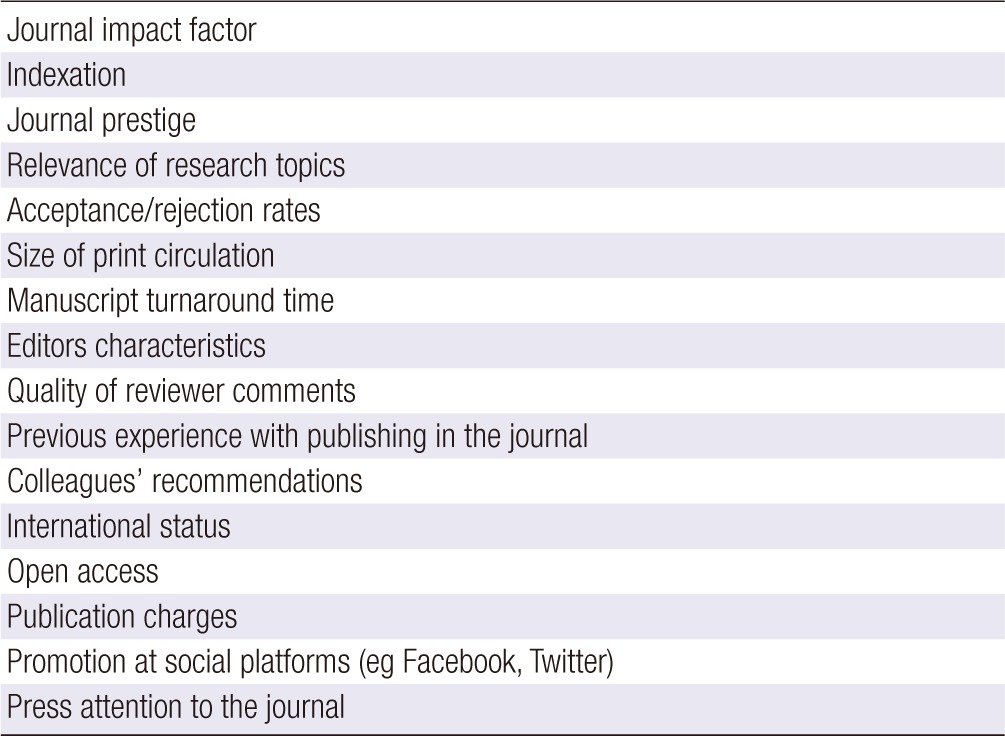Choosing the right journal for submission of a manuscript is a tough task for most authors. Experts in writing and editing advise selecting the journal at the start of manuscript writing, so that the article can be addressed to the audience of the chosen journal and presented in a general style and length preferred by that journal, thereby helping to avoid unnecessary rejections and delays with publication of the research data and opinion pieces that may advance science. For authors from mainstream science countries, the choice is often determined by the institutional policies, regulations of research funding agencies and knowledge of journal rankings. In fact, scholarly publications are now valued as a hard currency for academic promotion and for enhancing the position of the leading academic and research institutions in prestigious world rankings.
The emerging scientific powers are also increasingly concerned with what and where their scientists publish, trying to incentivise publications in high-impact journals. However, not all good works find their home in these journals, posing a dilemma - which of the lower rank journals would be suitable for submission.
Over the past few years the global publications boom and uncontrolled growth in the number of journals offering rapid publication and different models of open access have created new sorts of problem, complicating the authors' choices further and diminishing the value of their papers which appear in journals with 'soft' quality controls and poor editorial practices. The manuscripts of 'desperate' authors, which fail to pass the rigorous peer review in established journals and are subsequently submitted to non-selective journals with commercial interests, shake the good traditions of scholarly publishing. And it seems that the problem lies not just with inappropriate choices of novice authors but, to a large extent, with changes in the seasoned authors' preferences (Table 1).
Table 1.
Main factors affecting the authors' choices of target journals

The latest widely circulated global opinion poll, of around one thousand academics, indicates that peer review and other quality factors are no longer the main determinants of submission choice (1). Instead, relevance of research field (24%), impact factor (22%) and indexation (15%) are the top three factors pointed to by most seasoned authors. Interestingly, open access (7%) and publication fees (6%) appeared to be the least important factors.
Other than this opinion poll, a few surveys have analysed authors' preferences for the most suitable journals, with evidence being produced primarily for biomedicine. In 1992, the general medical faculty of Stanford University (n = 305) were asked to rank factors affecting their submission choices (2). The results distinguished the journal's prestige, readership, relevance of the published topics, acceptance rate, print circulation, manuscript turnaround time, the editors' and reviewers' characteristics as the main determinants of initial submissions. For subsequent submission after a rejection, however, the acceptance rate was ranked as the most important factor. Unsurprisingly, other recent surveys have indicated that the current active authors consider the journal impact factor as the crucial player in the field (3, 4), and that no alternative impact indicator has yet gained a comparable rank (4).
The 'obsession' with high-impact journals is a phenomenon of the 'big science' era, and it reflects the authors' wish to publish their best papers in widely visible and well cited media. As a consequence of 'the impact factor game', it has become a common practice to initially target journals with high impact factors and, in case of rejections, embark on the lower rank journals. This practice overburdens the editors and reviewers, delays publication of potentially valuable works and frustrates the authors, to name just a few pitfalls. Knowledge of the annually updated journal rankings, based on the Web of Science (WoS) and the Journal Citation Reports (JCR) data, may help the authors choose the right journal, especially when a combination of impact indicators over several years is analysed. It is particularly helpful to familiarise the authors with the rankings in their subject categories and closely related fields of science. By complementing the JCR data with alternative, and particularly Scopus-based metrics such as the journal h index and SCImago Journal Rank (SJR), the authors may make better choices when matching journals to the 'quality' of their papers (5).
Journal publishers and editors are in a good position to guide authors by displaying a variety of impact indicators on their journals' websites. The latter is particularly in line with the San Francisco Declaration on Research Assessment (6), which has been signed by 155 journal editors and academics and 82 research institutions, funding bodies and associations, including the European Association of Science Editors (EASE). Earlier EASE published a statement discouraging the reliance on impact factor as a proxy of the quality of individual papers (7).
It should be stressed that the Web of Science database is a hub for around 12,000 successful journals. There are however many more journals indexed by other bibliographic databases, including specialised ones, serving the purpose of publishing-distributing validated information of interest to a specific community of readers (8). In the era of digitisation any good paper published in a national or a small professional journal can reach its readership by basic visibility on research platforms and search engines such as Google Scholar. This is particularly important to realise for authors, research managers and funding agencies of small and national scientific communities, where the impact factor game keeps a large proportion of good papers away from national journals and sometimes distracts attention from topics of national importance (9, 10). Perhaps the only viable solution for publishers and editors of small national journals, trying to attract quality papers, is to expand the international reach of their journals (10).
Authors who wish to reach wider readership and rapidly distribute results of their studies such as large trials may target open-access journals. The open access model is relatively new to a publishing market, which entails a range of publication charges. An increasing number of traditional journals have switched to different models of open access, with immediate or delayed archiving in digital libraries such as PubMed Central. Though some research funders mandate and pay for open access, not all individual authors have such funding and therefore choose journals discounting or waiving open access fees. Fortunately, there are currently many journals of professional and national communities operating an open access model without charging their authors. The author pays model is seen by most as a disincentive for choosing a journal (11). When authors are asked to choose between open and traditional access, they need to decide whether the open access brings any added benefit. Actually, not all scholarly papers may have improved citation chances with the open access (eg letters, case reports, brief communications, articles in small professional and national journals). Moreover, available evidence suggests that open access has not gained an advantage over the traditional subscription model in terms of citations (12), and that the overall publishing quality is more important than simply increased exposure to readership (11).
The attention of the networking media and press to a journal is gaining worldwide popularity. Currently, any large trial, cohort study or review in a high-rank journal attracts comments, which are being posted on the websites and are published in newspapers. For example, the BMJ frequently posts such comments on their blog and takes selected ones for publication as the journal letters. An increasing number of journals, aiming to reach wider audience, encourage posting of papers on individual, institutional and specialised repositories such as ResearchGate and promoting the contents on Facebook, LinkedIn and Twitter. Though the efficiency of such promotion has not been widely assessed, it seems to be an ethical option for building up awareness of the journal and for attracting authors, who may cite and submit their own papers to the journal.
To sum up, a variety of factors that influence the authors' choices have emerged in the past few years. A prime concern for current authors is whether the publication options offer good chances for citations, which are crucially important for academic competitiveness. The citations are equally important for the journals, who are struggling to improve and maintain their ranks (13, 14). What may suffer as a consequence of the global competition is quality, thereby demanding a more comprehensive approach to the avenue of publication and its promotion.
References
- 1. http://howtopublishinjournals.com/2013/05/27/key-factors-when-selecting-a-journal-poll-results/?goback=.anp_2569570_1369928456758_1. [accessed on 1 June 2013].
- 2.Frank E. Authors' criteria for selecting journals. JAMA. 1994;272:163–164. [PubMed] [Google Scholar]
- 3.Søreide K, Winter DC. Global survey of factors influencing choice of surgical journal for manuscript submission. Surgery. 2010;147:475–480. doi: 10.1016/j.surg.2009.10.042. [DOI] [PubMed] [Google Scholar]
- 4.Özçakar L, Franchignoni F, Kara M, Muñoz Lasa S. Choosing a scholarly journal during manuscript submission: the way how it rings true for physiatrists. Eur J Phys Rehabil Med. 2012;48:643–647. [PubMed] [Google Scholar]
- 5.Bornmann L, Marx W, Gasparyan AY, Kitas GD. Diversity, value and limitations of the journal impact factor and alternative metrics. Rheumatol Int. 2012;32:1861–1867. doi: 10.1007/s00296-011-2276-1. [DOI] [PubMed] [Google Scholar]
- 6.San Francisco Declaration on Research Integrity. [accessed on 1 June 2013]. Available at http://www.ascb.org/SFdeclaration.html.
- 7.EASE statement on inappropriate use of impact factors. Eur Sci Ed. 2007;33:99–100. [Google Scholar]
- 8.Gasparyan AY. Bibliographic databases: some critical points. J Korean Med Sci. 2013;28:799–800. doi: 10.3346/jkms.2013.28.6.799. [DOI] [PMC free article] [PubMed] [Google Scholar]
- 9.Uysal S, Coker C. Scientific medical journals in Turkey: current state and goals. Eur Sci Ed. 2011;37:109–110. [Google Scholar]
- 10.Massarrat S, Kolahdoozan S. Critical assessment of progress of medical sciences in Iran and Turkey: the way developing countries with limited resources should make effective contributions to the production of science. Arch Iran Med. 2011;14:370–377. [PubMed] [Google Scholar]
- 11.Warlick SE, Vaughan KT. Factors influencing publication choice: why faculty choose open access. Biomed Digit Libr. 2007;4:1. doi: 10.1186/1742-5581-4-1. [DOI] [PMC free article] [PubMed] [Google Scholar]
- 12.Björk BC, Solomon D. Open access versus subscription journals: a comparison of scientific impact. BMC Med. 2012;10:73. doi: 10.1186/1741-7015-10-73. [DOI] [PMC free article] [PubMed] [Google Scholar]
- 13.Gasparyan AY. Get indexed and cited, or perish. Eur Sci Ed. 2011;37:66. [Google Scholar]
- 14.Gasparyan AY, Ayvazyan L, Kitas GD. Biomedical journal editing: elements of success. Croat Med J. 2011;52:423–428. doi: 10.3325/cmj.2011.52.423. [DOI] [PMC free article] [PubMed] [Google Scholar]



